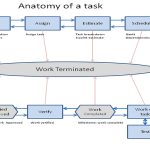You have probably used or heard about Agile Project Management, but chances are not about company-wide Agile management practice.
To be successful today, entrepreneurs and businesses need to be agile not just in managing their projects but in everything they do in their businesses.
From human resources to manufacturing, procurement, sales, and marketing all aspects of a business needs to run on agile principles for a company to become Agile.
A few years ago Mark Andreessen wrote an insightful article in Wall Street Journal called, Why software is eating the world. In it, Mark argued that software companies will soon dominate the market and everybody else will be left behind.
More recently Forbes published an article by Steve Denning titled why Agile is eating the world. It is a great article, I recommend everyone reading it.
In the article, Denning argues it is not the software that is taking over the world, but companies who practice Agile who are becoming the dominant players in the marketplace.
What proof do we have that the Agile practice is the only way that produces results in the 21-century economy?
In 2018, out of the five biggest corporations in the world, all five are practicing Agile. Yes, you heard me right. The five biggest corporations in the world are all Agile driven.
Amazon, Google, Apple, Facebook, and Microsoft all have adapted Agile management to survive and thrive. Did you notice all five are also primarily software vendors?
That should be expected since Agile has been a by-product or software industry and these companies have been in the forefront of embracing Agile.
So what is Agile management and how do you stir your company to the Agile promise land?
You may ask, only software companies or high tech companies have a chance to become Agile?
No, you do have to to be a software company to become agile. Any business like manufacturing, services or retail can become Agile.
[clickToTweet tweet=”Agile management can make your company the next Amazon or Google!” quote=”To be successful, businesses need to be agile not just in managing projects but in all they do.” theme=”style4″]
What is Agile Management?
In the following paragraphs, we define what Agile practice is in a company-wide setting and help you get started in making your business an Agile business.
The transition would not be easy, but not impossible. The first thing you need to do is to make sure every everybody in your organization from executives to first-line managers and key employees agrees and are committed to the agile way of doing business.
Remember that agile is a democratic way of managing and not a dictatorship form. You need everybody’s 100% commitment and backing to become agile and succeed.
1-Small is beautiful and yet efficient
To run a business agile, your organization needs to be lean. The excess fat in any organization is the killer of efficiency and productivity very much like body fat is in the human body.
Every person in your organization needs to have a precisely defined job and be 100% utilized. If anyone is not employed full time, outsource what they do.
The same goes for every asset your business owns or uses to run the operations. Buildings, equipment, and services you use to run the business all need be just what the business needs and nothing more.
This is even true for the capital you use to run the business. If you waste money even in small amount, you will be less agile.
Every penny should go to make the business run faster and become more productive.
2-Customer is the king
In Agile business, the customer is the king (or the queen). Your business should have one goal and one goal only; to satisfy the customer’s needs and wishes.
To be customer oriented is easier said than done. You need to put the customer at the center of all actions and decisions that the company makes.
You are not trying to sell goods or services to customers, but you are offering the customers great value which they can’t live without!
Your customers will become your best salespeople and fans.
3-Make decision fast
In agile management, you need to make decisions fast, really fast. You can’t wait until you have all the data and information which you think you need, to make a decision.
If you do that, by the time you have finally made a decision, the market/competition has changed and your decision could be wrong after all.
As a rule of thumb, if you already have 70% of the data you need, go ahead and decide. Waiting for any longer could just harm your chances of reaching the goal
In addition, if there is disagreement about how to proceed among the team members, use what Jeff Bezos, the CEO of Amazon does. When there is disagreement on an issue, the team makes a decision and commits even those who disagree are 100% committed.
4-Do, Measure, and Redo
To practice agile, you need to change fundamentally how you manage things.
After a decision is made and implemented, you need to monitor and measure the outcome using real data. Based on the result, you may need to modify/change what you have been doing.
The combination of short decision making and the ability to measure the result and react in time is a potent business asset.
This is what we mean by agile management, everything is checked and rechecked based on collected data.
If your business does not have the data on all its operations, then go and figure out how to get them first. Without real data, Agile management is impossible.
The beauty of this approach is that it makes mistakes less costly and enable you to change course in a very short time when needed.
5-Transparency is the new rule
In the age of agile, transparency is becoming the new corporate rule which no business can do without. If you want to make decisions fasts and more importantly make corrections faster, your organization needs to be totally transparent.
Hiding facts and data from others, establishing chiefdoms and fighting for egos and position does not fit the agile model.
For agile to work, a flat organizational structure is needed in the organization. If the management levels from the CEO to the workers is more than 4 levels in your organization, then you have too much management fat in your organization and need to trim the extra fat.
Before becoming Agile you need to cut the excess fat layer from your organization. This requires that you give more responsibility to everyone on your team.
The CEO’s number one objective when trying to go agile is to make sure the business, the people and everything in it, is 100% transparent.
Everybody should have access to the same data if they are part of the team that makes decisions or does the actual work.
6-Collaborate or Die
In the age of agile, collaboration becomes even more necessary and valuable than other organizational structures.
If your organization fails to collaborate, it will be destined to fail and disappear in the marketplace.
The number one enabler of productivity in the era of social media is collaboration. The new work tools make collaboration easier to achieve.
But, the organization needs to be receptive to collaboration. No tool can force a team to collaborate. The collaboration should be ingrained in the organization’s DNA.
7-Get rid of underperformers
For a business to thrive, it needs the best talent it can afford. It is important to always evaluate the employees and find out who is doing fine and those who need to go.
If you are an established company, once a year review is sufficient. For startups, one year may be too long. The review should happen every six months or less.
I know the above statement sounds mean and heartless, but remember a business is not a social club and it needs the best resources to grow.
You owe it to those who work hard, to the shareholders and yourself to make sure your business got the best talent you can afford,
Granted you can’t compete with Google or Amazon when it comes to attracting talent. But if you want to become as successful as Amazon or Google one day, you better start doing as they do.
One caveat here, you need to provide training and support to make sure your employees can achieve the best they are able to. The money and effort you spend on employee training is an important investment in the business.
The Pros of Agile Management
The following is a partial list of the benefits of Agile management.
- Makes your business productive
- It reduces cost and increases margins on business operations
- Makes your business more versatile and able to respond to change
- Improves the quality of the products or service you offer
- It keeps your customers happy
The Cons of Agile
The following is a partial list of problems/issues with Agile management.
- You need to work hard
- Your employees need to work hard
- In general, you need to pay higher wages
- You may become too successful too fast and decide not to work 🙂
Conclusion
If you are a new entrepreneur or business owner and want to know about diverse topics in managing and running your business, the resources below could be very helpful.
Feel free to share your experiences turning your company to Agile with us. We would love to hear your stories and will publish them in the Collaboration Corner Journal.
2-Collaborative project management
3-The dangers of big tech companies
4-Hierarchy of needs in managing projects
8-Waterfall project management software
11-Agile startup, eight principles you need to know




